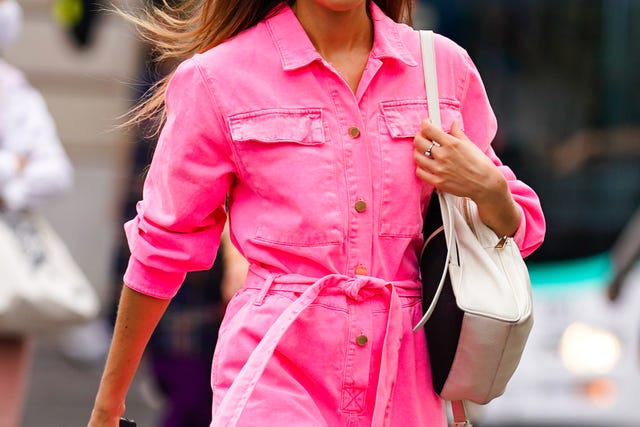
Edward BerthelotGetty Images
The Year in Personal Style is a week of essays about how 2021 changed our relationship to getting dressed.
On a heat-waved evening last summer, in that sliver of the season before the onset of the delta variant, my girlfriend and I went to a gay bar in the West Village. It was our four-month anniversary, yet we’d only experienced a handful of subway rides together, seated restaurant dinners, bars, actual dates. It was exhilarating to be able to finally plan one, complete with dinner and a live show—and to get dressed for each other. She wore a purple-and-white open-neck wraparound dress, and I wore a sleeveless striped jumpsuit, a gift that I’d received for my birthday and the second one I’d ever owned. Not until COVID times had I discovered jumpsuits, an appreciation that the absence of witness had allowed me to cultivate.
The endeavor of dressing myself throughout the pandemic has been significantly harder than in normal times, without the constraints and demands of necessity, without the pressure of expectations. As the urgency around “dressing well” (or dressing at all) slackened, along with the time limit on deciding—no bodega to fly in and out of for a yogurt parfait en route to an A train I’d just barely miss—the possibilities became endless. If I didn’t technically need to wear a certain item of clothing in concurrence with certain societal norms, should I? If I could wear sweats all day, was there an incentive to do otherwise? Did a pair of fancy trousers hold intrinsic value if they were worn on legs going nowhere and seen by almost no one?
Indeed, these considerations applied more pressingly from the waist down. The start of the pandemic coincided with the release of my novel, which meant most of my evenings were spent visible from the top up, beheld in virtual launch events. But Zoom begets less scrutiny and is more forgiving of repeat outfits, so the question remained: At the end of the day (or rather, at its start), does a shirt get its value only when eyes are laid upon it? What is presentation with no one to present to?
As it happened, I was misjudging the relationship between clothing and necessity.
Prior to the pandemic, fashion seemed to me a collective frivolity, one I was willing to partake in. The purpose of clothes, as I saw it, was to provide cover (a burlap sack could suffice), but, realizing that our coverage could be adorned, we collectively decided to have some fun with it. And so fashion was born as a means of entertainment and representation, similar to one’s viewing choices on Netflix. In the process, it generated a highly lucrative industry. In line with this, I saw fashion’s value as deriving from its being witnessed, in the same way that a pastry’s value emerges when tasted.
This extrinsic assessment made sense in the context of expectations that I’ve long felt subjected to as a queer woman. If fashion seemed frivolous, it also seemed fraught. There’s an underlying assumption that sexual identity corresponds with certain fashion choices, that there’s a correlation between gender and sexual identity and fashion at all, which may seem liberating but can also be quite restrictive, as though there were an imperative to dress one’s sexuality. Even to vacillate between femme and tomboy, as some of us do (for me, it’s along the contours of the seasons), seeming to thwart categorization and binaries, can be interpreted as a statement that one may not intentionally be trying to make.
And so, with the external element removed, I felt relief. I was free to explore and to venture into new and varied territory: snap-button bodysuits, Gizeh Birkenstocks, fitted tank tops beneath flannel shirts. And somehow, without witness, fashion finally became necessary—not as a means of self-expression, hetero-defying or otherwise, but as an end in itself, an extension of self rather than a representation of self, the territory and not the map. Unseen, I tapped into my truest fashion sense, my desert island choices, and discovered what I wanted if no one was there to see, and where I was willing to go.
This year, with less time on Zoom and more social outings, along with a new relationship (the ultimate urgency-heightener), I did my best to keep the gaze at bay and maintain an internally guided fashion sense. Leave meeting, enter jumpsuit.
This content is created and maintained by a third party, and imported onto this page to help users provide their email addresses. You may be able to find more information about this and similar content at piano.io
The Year I Learned What Fashion Is Really For
Source: Filipino Journal Articles

0 Comments